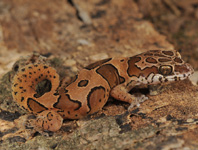Abstract
Two new species of ground-dwelling geckos of the genus Cyrtodactylus (Geckoella) are described from the Mysore Plateau, in southern India. The new species are members of the C. collegalensis species complex, with 8.7 % uncorrected ND2 sequence divergence from each other and greater than 10 % divergence from described members of the C. collegalensis complex, from which they differ in subtle aspects of colour pattern and morphometric ratios. The type localities of the new species are ~ 130 km apart, and 100 km and 225 km from the type locality of C. collegalensis in the Biligiriranga Hills. The discovery of these new species in isolated mountains within a small area suggests other high elevation areas in the region may have undescribed species, and a redefinition of biodiversity patterns in peninsular India.References
Agarwal, I. & Karanth, K.P. (2015) A phylogeny of the only ground-dwelling radiation of Cyrtodactylus (Squamata, Gekkonidae): diversification of Geckoella across peninsular India and Sri Lanka. Molecular Phylogenetics and Evolution, 82, 193–199.
http://dx.doi.org/10.1016/j.ympev.2014.09.016Agarwal, I., Mirza, Z.A., Pal, S., Maddock, S.T., Mishra, A. & Bauer, A.M. (2016) A new species of the Cyrtodactylus (Geckoella) collegalensis (Beddome, 1870) complex (Squamata: Gekkonidae) from Western India. Zootaxa, 4170 (2), 339–354.
http://dx.doi.org/10.11646/zootaxa.4170.2.7Bauer, A.M. (2003) Descriptions of seven new Cyrtodactylus (Squamata: Gekkonidae) with a key to the species of Myanmar (Burma). Proceedings of the California Academy of Sciences, 54, 463–498.
Bauer, A.M., Masroor, R., Titus-McQuillan, J., Heinicke, M.P., Daza, J.D. & Jackman, T.R. (2013) A preliminary phylogeny of the Palaearctic naked-toed geckos (Reptilia: Squamata: Gekkonidae) with taxonomic implications. Zootaxa, 3599, 301–324.
http://dx.doi.org/10.11646/zootaxa.3599.4.1Cervenka, J., Frynta, D. & Kratochvi, l.L. (2008) Phylogeny and taxonomy of the Middle Eastern geckos of the genus Cyrtopodion and their selected relatives. Zootaxa, 1931, 25–36.
Deepak, V., Giri, V.B., Asif, M., Dutta, S.K., Vyas, R., Zambre, A.M., Bhosale, H. & Karanth, K.P. (2016) Systematics and phylogeny of Sitana (Reptilia: Agamidae) of Peninsular India, with the description of one new genus and five new species. Contributions to Zoology, 85, 67–111.
Deraniyagala, P.E.P. (1945) A new gymnodactylid gecko from Ceylon. Spolia Zeylanica, 24, 99–102.
Ganesh, S.R. & Arumugam, M. (2016) Species richness of montane herpetofauna of southern Eastern Ghats, India: a historical resume and a descriptive checklist. Russian Journal of Herpetology, 23, 7–24.
Ganesh, S.R. & Asokan, J.R. (2010) Catalogue of Indian herpetological specimens in the collection of the Government Museum Chennai, India. Hamadryad, 35, 46–63.
Gower, D.J., Agarwal, I., Karanth, K.P., Datta-Roy, A., Giri, V.B., Wilkinson, M. & Mauro, D.S. (2016) The role of wet-zone fragmentation in shaping biodiversity patterns in peninsular India: insights from the caecilian amphibian Gegeneophis. Journal of Biogeography, 43, 1091–1102.
http://dx.doi.org/10.1111/jbi.12710Karanth, P.K. (2003) Evolution of disjunct distributions among wet-zone species of the Indian subcontinent: testing various hypotheses using a phylogenetic approach. Current Science, 85, 1276–1283.
Lajmi, A., Giri, V.B. & Karanth, P.K. (2016) Molecular data in conjunction with morphology help resolve the Hemidactylus brookii complex (Squamata: Gekkonidae). Organisms Diversity & Evolution, 1–19.
http://dx.doi.org/10.1007/s13127-016-0271-9Morley, R.J. (2000) Origin and evolution of tropical rain forests. Wiley, Chichester, UK.
Silvestro, D. & Michalak, I. (2012) RaxmlGUI: a graphical front-end for RAxML. Organisms Diversity & Evolution, 12, 335–337.
http://dx.doi.org/10.1007/s13127-011-0056-0Smith, M.A. (1935) The fauna of British India, including Ceylon and Burma. Reptilia and Amphibia. Volume II. Sauria. Taylor and Francis, London. xiii + 440 pp [ 1 plate., 2 folding maps]
Srinivasulu, C., Srinivasulu, B. & Molur, S. (Compilers) (2014) The Status and Distribution of Reptiles in the Western Ghats, India. Conservation Assessment and Management Plan (CAMP). Wildlife Information Liaison Development Society, Coimbatore, Tamil Nadu.
Stamatakis, A. (2006) RAxML-VI-HPC: maximum likelihood-based phylogenetic analyses with thousands of taxa and mixed models. Bioinformatics, 22, 2688–2690.
http://dx.doi.org/10.1093/bioinformatics/btl446Tamura, K., Peterson, D., Peterson, N., Stecher, G., Nei, M. & Kumar, S. (2011) MEGA5: molecular evolutionary genetics analysis using maximum likelihood, evolutionary distance, and maximum parsimony methods. Molecular Biology and Evolution, 28, 2731–2739.
http://dx.doi.org/10.1093/molbev/msr121Valdiya, K.S. (2010) The Making of India: Geodynamic Evolution. Macmillan India, 924 pp.

